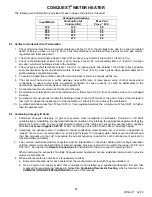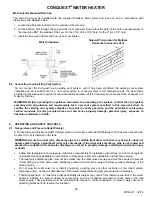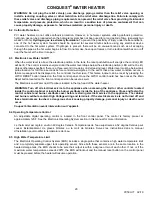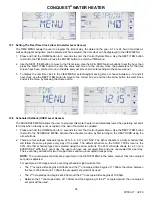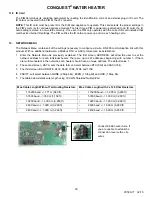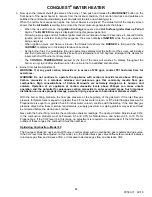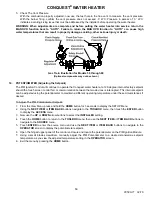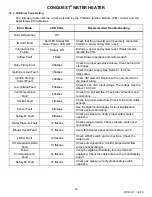
CONQUEST
®
WATER HEATER
38
PV500-71 02/16
11.3 Replacing the Fuse
The 24 VAC input and output circuits of the PIM are protected by a 2.0 Amp fuse.
11.4 Self-Check/Control Failure
The PIM confirms the integrity of the gas valve relay contacts to insure safety. It also monitors the processor
memory and software execution for proper program flow. If the control detects an error in its software or hardware,
all outputs are turned off and the LED displays a steady ON condition. If this condition persists after an attempt to
restart then the control must be replaced.
11.5 System Safety Checks
The PIM monitors the safety switches, temperature sensors, supply voltage, and blower speed and will go to soft
lockout until the error condition is corrected. Individual LED diagnostic codes or messages on the RS485
communications help identify the problem for efficient troubleshooting.
11.6 Flame Current Measurements
The PIM supports direct measurement of flame signal strength using the flame current test pins (FC+, FC-) on
connector P2. Flame current may be measured by a micro-ammeter, or alternately by using a standard digital
voltmeter. The signal on P2 is calibrated to 1 micro-amp/volt, so flame current in micro-amps can be directly read on
the volts scale.
The control display user interface is capable of displaying an approximation of flame current up to 5 micro-amps
.
11.7 Non-Volatile Lockout/Manual Reset
The PIM normally allows for volatile ignition lockout where a lockout condition is reset by a loss in 24VAC power or
the call for heat demand. In certain applications or where required by standards (such a CSD-1), it can be
configured through the parameter settings for non-volatile lockout after ignition failure. In this case the lockout may
only be reset by the on-board manual reset button, or the remote reset input.
condition may be caused by a sensor failure or a faulty control board.
HTR TOP
Indicates a problem with the top temperature sensor, possibly a broken or
shorted sensor wire or failed sensor.
NOTE
: The top sensor and the high
limit sensor or located in the same probe body.
8 11
HI LIMIT
Indicates a problem with the high limit temperature sensor, possibly a
broken or shorted sensor wire or failed sensor.
NOTE
: The top sensor and
the high limit sensor or located in the same probe body.
8 14
HTR BOT
Indicates a problem with the bottom temperature sensor, possibly a
broken or shorted sensor wire or failed sensor.
8 12
VENT
Indicates a problem with the vent temperature sensor, possibly a broken
or shorted sensor wire or failed sensor.
8 13
LOGASPRES FAIL
The low gas pressure safety switch (optional) is not sensing the minimum
gas pressure required for safe burner operation. Check the gas pressure
to ensure that the minimum is available. If the gas pressure is adequate
check for fluctuating gas pressure or a faulty pressure switch.
9 10
REM PROV FAIL
The remote proving circuit, when used, is designed to check for the
operation of ancillary mechanical room equipment such as a fresh air
damper or flow switch. Check for the proper function and correct wiring of
such equipment.
10 8
LOW WATER FAIL
The electronic low water cutoff is no longer sensing water at its probe.
This could also be cause by a faulty low water board or sensor
12 7
HTR LOST
This could be caused by a poor connection between the PIM control and
the digital control display or failure of either device.
14 6
HIGASPRES
Check the gas pressure to ensure that the building supply doesn’t exceed
the value on the heater rating plate. If the gas pressure is within rated
limit, check for a faulty pressure switch.
15 26

